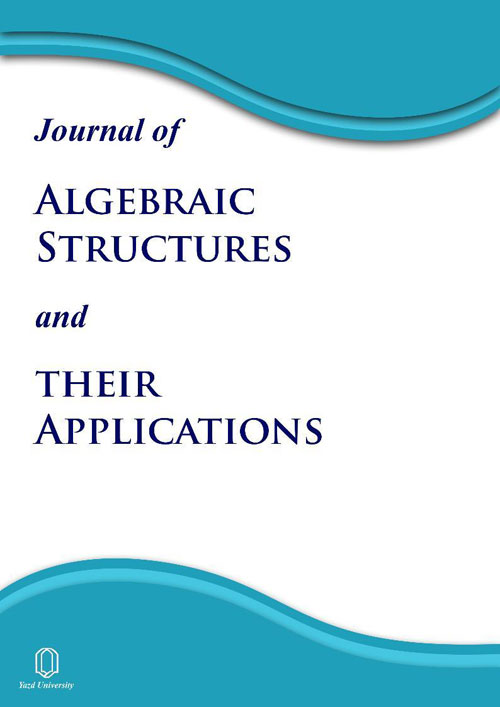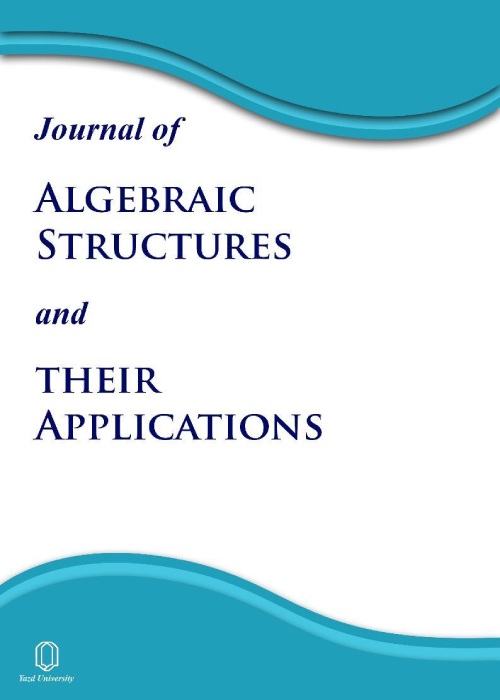فهرست مطالب

Journal of Algebraic Structures and Their Applications
Volume:6 Issue: 2, Summer and Autumn 2019
- تاریخ انتشار: 1398/08/10
- تعداد عناوین: 12
-
-
Pages 1-7Let $A$ be a commutative ring with nonzero identity, and $1leq n<infty$ be an integer, and $R=Atimes Atimescdotstimes A$ ($n$ times). The total dot product graph of $R$ is the (undirected) graph $TD(R)$ with vertices $R^*=Rsetminus {(0,0,dots,0)}$, and two distinct vertices $x$ and $y$ are adjacent if and only if $xcdot y=0in A$ (where $xcdot y$ denote the normal dot product of $x$ and $y$). Let $Z(R)$ denote the set of all zero-divisors of $R$. Then the zero-divisor dot product graph of $R$ is the induced subgraph $ZD(R)$ of $TD(R)$ with vertices $Z(R)^*=Z(R)setminus {(0,0,dots,0)}$. It follows that if $Gamma(A)$ is not perfect, then $ZD(R)$ (and hence $TD(R)$) is not perfect.In this paper we investigate perfectness of the graphs $TD(R)$ and $ZD(R)$.Keywords: annihilator graph, Zero-divisor, Complete graph
-
Pages 9-12Let $G$ be a finite group. We say that an element $g$ in $G$ is a vanishing element if there exists some irreducible character $chi$ of $G$ such that $chi(g)=0$. In this paper, we classify groups whose set of vanishing elements is exactly a conjugacy class.Keywords: Finite groups, vanishing elements, conjugacy classes
-
Pages 13-20In this work, we introduce $H^*$-condition on the set of submodules of a module. Let $M$ be a module. We say $M$ satisfies $H^*$ provided that for every submodule $N$ of $M$, there is a direct summand$D$ of $M$ such that $(N+D)/N$ and $(N+D)/D$ are cosingular. We show that over a right perfect right $GV$-ring,a homomorphic image of a $H^*$ duo module satisfies $H^*$.Keywords: $H$-supplemented module, cosingular module, $H^*$-module
-
Pages 21-38Suppose $X$ is a simple graph. The $X-$join $Gamma$ of a set ofcomplete or empty graphs ${X_x }_{x in V(X)}$ is a simple graph with the following vertex and edge sets:begin{eqnarray*}V(Gamma) &=& {(x,y) | x in V(X) & y inV(X_x) },\ E(Gamma) &=& {(x,y)(x^prime,y^prime) | xx^prime in E(X) or else x = x^prime & yy^prime in E(X_x)}.end{eqnarray*}The $X-$join graph $Gamma$ is said to be reduced if $x, y in V(X)$, $x ne y$ and $N_X(x) setminus { y} = N_X(y) setminus { x}$ imply that $(i)$ if $xy notin E(X)$ then the graphs $X_x$ or $X_y$ are non-empty; $(ii)$ if $xy in E(X)$ then $X_x$ or $X_y$ are not complete graphs. The aim of this paper is to explore how the graph theoretical properties of $X-$join of graphs effect on its automorphism group. Among other results we compute the automorphism group of reduced complete-empty $X-$join of graphs.Keywords: $X-$join of graphs, reduced $X-$join of graphs, automorphism group
-
Pages 39-45Let $Gamma$ be a graph with adjacency eigenvalues $lambda_1leqlambda_2leqldotsleqlambda_n$. Then the energy of $Gamma$, a concept defined in 1978 by Gutman, is defined as $mathcal{E}(G)=sum_{i=1}^n|lambda_i|$. Also the Estrada index of $Gamma$, which is defined in 2000 by Ernesto Estrada, is defined as $EE(Gamma)=sum_{i=1}^ne^{lambda_i}$. In this paper, we compute the eigenvalues, energy and Estrada index of Cayley graphs on generalized dihedral groups. As an application, we compute these items for honeycomb toroidal graphs and Cayley graphs on dihedral groups.Keywords: Eigenvalue, Energy of graph, Estrada index, Cayley graph, Semi-Cayley graph
-
Pages 47-55Let $R$ be a commutative ring and let $I$ be an ideal of $R$. In this paper, we will introduce the notions of 2-absorbing $I$-prime and 2-absorbing $I$-second submodules of an $R$-module $M$ as a generalization of 2-absorbing and strongly 2-absorbing second submodules of $M$ and explore some basic properties of these classes of modules.Keywords: 2-absorbing submodule, weakly 2-absorbing submodule, 2-absorbing $I$-prime submodule, 2-absorbing second submodule, 2-absorbing $I$-second submodule
-
Pages 57-65Let $G$ be a finite group. The graph $D(G)$ is a divisibility graph of $G$. Its vertex set is the non-central conjugacy class sizes of $G$ and there is an edge between vertices $a$ and $b$ if and only if $a|b$ or $b|a$. In this paper, we investigate the structure of the divisibility graph $D(G)$ for a non-solvable group with $sigma^{ast}(G)=2$, a finite simple group $G$ that satisfies the one-prime power hypothesis, a group of type($A$),($B$) or ($C$) and certain metacyclic $p-$groups and a minimal non-metacyclic $p-$group where $p$ is a prime number. We will show that the divisibility graph $D(G)$ for all of them has no triangles.Keywords: conjugacy class, divisibility graph, metacyclic
-
Pages 67-80Let $R$ be a commutative ring with identity and $M$ be a unitary $R$-module. Suppose that $phi:S(M)rightarrow S(M)cup lbraceemptysetrbrace$ be a function where $S(M)$ is the set of all submodules of $M$. A proper submodule $N$ of $M$ is called an $(n-1, n)$-$phi$-classical prime submodule, if whenever $r_{1},ldots,r_{n-1}in R$ and $min M$ with $r_{1}ldots r_{n-1}min Nsetminusphi(N)$, then $r_{1}ldots r_{i-1}r_{i+1}ldots r_{n-1}min N$, for some $iinlbrace 1,ldots, n-1rbrace$ $(ngeqslant 3)$.In this work, $(n-1, n)$-$phi$-classical prime submodules are studied and some results are established.Keywords: $psi$-prime ideal, $phi$-prime submodule, n)$-$psi$-prime ideal, $(n-1, n)$-$phi$-prime submodule, $phi$-classical prime submodule
-
Pages 81-86Let $R$ be a commutative Noetherian ring. We prove that over a local ring $R$ every finitely generated $R$-module $M$ of finite Gorenstein projective dimension has a Gorenstein projective cover$varphi:C rightarrow M$ such that $C$ is finitely generated and the projective dimension of $Kervarphi$ is finite and $varphi$ is surjective.Keywords: Cover, Precover, Gorenstein projective, totally reflexive
-
Pages 87-100
Let $R$ be a commutative Noetherian ring with non-zero identity, $mathfrak{a}$ an ideal of $R$, $X$ an arbitrary $R$--module, $mathcal{F}$ a filtration of $operatorname{Spec}(R)$ which admits $X$, and $s, s', t, t'$ non-negative integers such that $s+ t= s'+ t'$. In this paper, we study the membership of $R$--modules $operatorname{H}^{s}_mathfrak{a}(operatorname{H}^{t- 1}(operatorname{C}_R(mathcal{F}, X)))$ and $operatorname{H}^{s'- 1}(operatorname{H}^{t'}_mathfrak{a}(operatorname{C}_R(mathcal{F}, X)))$ in Serre subcategories of the category of $R$--modules and find some sufficient conditions which ensure the existence of an isomorphism between them, where $operatorname{C}_R(mathcal{F},X)$ is the Cousin complex for $X$ with respect to $mathcal{F}$. As applications, we give some new facts and represent some older facts about the local cohomology modules and the Cousin complexes.
*The formula is not displayed correctly!Keywords: Cousin complexes, local cohomology modules, Serre subcategories -
Pages 101-113
The concept of fuzzy soft $Gamma$-hyperrings introduced by J. Zhan et al. as a generalization of the soft rings. In this paper, we prove the equivalence relation $mu^{ast}$ defined by J. Zhan et al. is a strongly soft $Gamma$-regular relation and hyperoperations defined on quotient fuzzy soft $Gamma$-hyperrings are just operations. Also, we define the equivalence relation $mu^{ast}_I$ as a generalization the relation $mu^{ast}$ and consider quotient fuzzy soft $Gamma$-hyperrings and isomorphism theorems by thisregular relation.
*The formula is not displayed correctly!Keywords: Gamma-hyperring, Gamma-hyperideal, fuzzy soft Gamma-hyperring, regular soft Gamma-relation, strongly soft Gamma- relation -
Pages 115-127
The solvable graph associated with a finite group $G$, denoted by ${Gamma}_{rm s}(G)$, is a simple graph whose vertices are the prime divisors of $|G|$ and two distinct primes $p$ and $q$ are joined by an edge if and only if there exists a solvable subgroup of $G$ whose order is divisible by $pq$. In this paper, we give acharacterization for projective special unitary groups $U_3(q)$ with some certain conditions by the solvable graph.
*The formula is not displayed correctly!Keywords: solvable graph_degree pattern of solvable graph_simple group_rmODs-characterization of a finite group


